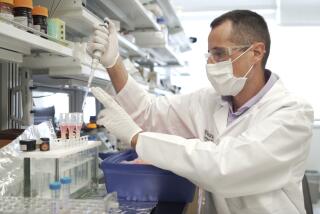Gene Defect Linked to Inherited Form of Alzheimer’s : Medicine: It is the first time that such an association has been found. The discovery could help identify people at risk.
- Share via
Researchers studying three generations of a large family in Indiana have for the first time associated a genetic defect with an inherited form of Alzheimer’s disease in humans.
Indiana University researchers report today in the journal Science that they have identified a specific gene that caused an inherited form of the degenerative disorder. Each family member who had the defective gene developed Alzheimer’s, while those who did not have the gene did not develop the disorder.
Isolation of the gene will make it possible to identify many individuals at risk of developing hereditary Alzheimer’s, which accounts for 15% to 20% of all Alzheimer’s cases. It also may lead to new ways to simplify diagnosis and treatment of the disorder, which affects about 4 million Americans and causes 100,000 deaths annually.
The discovery is “very exciting news,” said neurologist Zevan Khachaturian of the National Institute on Aging.
“It adds to an understanding of the cascade of events that go on in Alzheimer’s disease,” said Gene Cohen, acting director of the National Institute on Aging. “The more steps in this sequence that we can identify, the better are our opportunities to intervene at some point.”
Alzheimer’s, which normally strikes after the age of 65, is characterized by memory loss, disorientation, depression and deterioration of bodily functions. The inherited form of the disease strikes earlier, between the ages of 45 and 55. Death usually occurs within seven years of diagnosis.
Although the new results are directly applicable only to families with the hereditary form of Alzheimer’s, most researchers are confident that they will shed light on the 80% of Alzheimer’s victims who seemingly develop the disease at random. The majority of neurologists agree that there is also a genetic component to this so-called sporadic Alzheimer’s and that its mechanism must be very similar to that of the hereditary form.
The most noticeable biological sign of Alzheimer’s is the presence of protein plaques in the regions of the brain that control memory and learning. The primary component of these plaques, which are observable only at autopsy, is a protein called beta-amyloid--a product of the deterioration of a larger protein called amyloid precursor protein, or APP.
Although some neurologists have argued that the plaques are simply a side effect of the process that causes Alzheimer’s, a growing body of evidence indicates that they are the cause.
In the last few months, several different research groups have reported that the introduction of these proteins into rodents caused Alzheimer’s plaques and brain cell death. In no case, however, have the researchers reported behavioral or memory effects associated with the proteins, so the link to Alzheimer’s is still tenuous.
The new results in humans provide a much stronger case that the proteins are the cause of the disorder.
The search for a gene associated with hereditary Alzheimer’s is difficult, according to molecular geneticist Merrill D. Benson of the Indiana University Medical Center, because the victims die so quickly after diagnosis. If researchers find a family with the disorder, Alzheimer’s victims in the previous generation will have already died off, while those in the next generation will be too young to have developed it.
The new study was made possible because Indiana University neurologist Wolfgang Zeman, who discovered the family in the 1960s, saved tissue and brain samples from both affected and unaffected individuals. Benson and his colleagues were able to study samples from 31 members of three generations of the family.
The father of the family died of Alzheimer’s at 57. Three of his nine children died of Alzheimer’s, at ages 48, 49 and 53. One of his grandchildren has now developed Alzheimer’s at 44.
In each of the five individuals who developed Alzheimer’s, Benson and his colleagues found a defect in the gene that serves as a blueprint for APP. That defect was not found in those family members who had not developed Alzheimer’s before the age of 55.
“Discovering that the family members with the altered gene have Alzheimer’s disease and those with the unchanged gene do not confirms our suspicions” that a defective APP gene causes hereditary Alzheimer’s, said Khachaturian. “Finding such a clear-cut example is very exciting news.”
None of the other 13 members of the third generation are old enough to have developed Alzheimer’s, Benson said, but at least two of them have the defective gene. Benson has not told them they have the gene because “we are trying to be 100% sure. As a responsible physician, you can’t tell somebody something if you are not sure.”
The team is also looking at members of the fourth generation, but Benson would not reveal whether any of those carried the gene. He added that their test could be used for prenatal screening for Alzheimer’s, but that he has no plans to do so because of the inherent ethical problems involved in decisions to abort a fetus.
BACKGROUND
Scientists have long speculated about whether deposits of a protein called beta-amyloid in the brain cause Alzheimer’s disease or are merely side effects. Recent research in rats has shown that the deposits can cause the death of brain cells involved in memory and learning. Now, the identification of a defective gene for the protein in families with hereditary Alzheimer’s provides the strongest evidence yet that the deposits cause the disorder.






